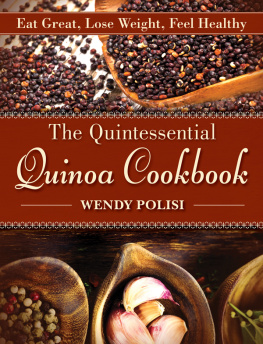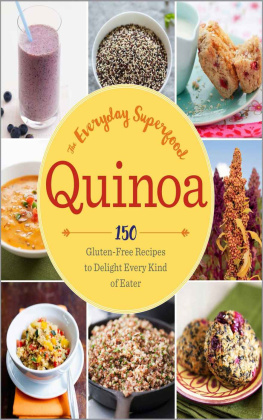The Quinoa Cookbook
Everyday Superfood Recipes for a Gluten-Free Diet
by John Chatham

Rockridge University Press
Copyright 2012 by Rockridge University Press, Berkeley, California
No part of this publication may be reproduced, stored in a retrieval system or transmitted in any form or by any means, electronic, mechanical, photocopying, recording, scanning or otherwise, except as permitted under Sections 107 or 108 of the 1976 United States Copyright Act, without the prior written permission of the Publisher. Requests to the Publisher for permission should be addressed to the Permissions Department, Rockridge University Press, 918 Parker St, Suite A-12, Berkeley, CA 94710.
Limit of Liability/Disclaimer of Warranty: The publisher and the author make no representations or warranties with respect to the accuracy or completeness of the contents of this work and specifically disclaim all warranties, including without limitation warranties of fitness for a particular purpose. No warranty may be created or extended by sales or promotional materials. The advice and strategies contained herein may not be suitable for every situation. This work is sold with the understanding that the publisher is not engaged in rendering medical, legal, or other professional advice or services. If professional assistance is required, the services of a competent professional person should be sought. Neither the publisher nor the author shall be liable for damages arising herefrom. The fact that an individual, organization or Web site is referred to in this work as a citation and/or a potential source of further information does not mean that the author or the publisher endorses the information the individual, organization or Web site may provide or recommendations they/it may make. Further, readers should be aware that Internet Web sites listed in this work may have changed or disappeared between when this work was written and when it is read.
For general information on our other products and services or to obtain technical support, please contact our Customer Care Department within the U.S. at (866) 744-2665, or outside the U.S. at (510) 253-0500.
Rockridge University Press publishes its books in a variety of electronic and print formats. Some content that appears in print may not be available in electronic books, and vice versa.
TRADEMARKS: Rockridge University Press and the Rockridge University Press logo are trademarks or registered trademarks of Callisto Media Inc. and/or its affiliates, in the United States and other countries, and may not be used without written permission. All other trademarks are the property of their respective owners. Rockridge University Press is not associated with any product or vendor mentioned in this book.
ISBN: 978-1-62315-000-6
Table of Contents
Chapter 1
Say Hello to Quinoa
H ave you grown tired of staring at your pantry, wondering how to make old standby accompaniments like rice or potatoes exciting again? Or are you trying to decrease your intake of carbohydrates while still maintaining healthy levels of lean protein? Imagine a completely natural food thats rich in protein and other nutrients and can play a major supporting role at breakfast, lunch and dinner. Sounds like a fantasy? Its notyouve just envisioned quinoa!
Quinoa is a grain (although technically a seed) that has only recently received wide mainstream recognition for its health benefits and ease of preparation, despite having been domesticated as a food crop for thousands of years. Serving as an easy substitute for rice and other carbohydrates, quinoa is emerging as a viable option for those seeking healthier diet options, but who dont want foods that are hard to find or which require complex preparation. Quinoa is quick. Quinoa is easy. If you know how to make rice, you already know how to make quinoa!
Once only found in health food stores as a bulk item, quinoa is quickly becoming available to consumers at the local grocery store. You can often find quinoa in packages mixed with seasonings such as garden vegetable, garlic and herb and international flavor variations. Frequently located in the same aisle as other pantry staples such as rice and beans, quinoa has the capacity to blend in with your meal. This makes quinoa an easy choice, even in households with fussy eaters.
But even as quinoa makes inroads into mainstream home cooking, adventurous consumers can still push the envelope with unique gourmet products that offer different varieties of the grain. Just as ricelong available only as a par-boiled quick-cook producthas bloomed into dozens of exotic varieties such as Jasmine, Forbidden and Basmati, so too has the diversity of quinoa expanded with red and black versions just now hitting store shelves.
The recipes in this book are designed to show you the vast potential of this simple and nutritious grain, with offerings ranging from breakfast cereals to side dishes and full dinner entrees. By the time you finish reading the last chapter, youll be ready to experiment with quinoa and come up with your own tasty preparations, using common ingredients that you probably already have on hand!

Chapter 2
Quinoa, Then and Now
T he Latin American geographer Alexander Von Humboldt, in analyzing ancient civilizations in the Andes, concluded that quinoa was to the Inca what wine was to the Greeks, wheat to the Romans, cotton to the Arabs. His statement was even more accurate than he could have imagined.
First cultivated as a food crop between 3,000 and 4,000 years ago in South America, in the region of the Andes that today is home to the nations of Ecuador, Bolivia, Columbia and Peru, quinoa has enjoyed a long history as a sustainable crop, and was critical to the survival and influence of ancient civilizations.
As a critical component of its culture and due to its ability to sustain itself, quinoa was considered to be sacred by the Incan people, who referred to the crop as The Mother Grain. This designation is frequently referenced by todays marketers, who seek to appeal to health-conscious consumers. Looking at the versatility of quinoa, its easy to see that the Inca werent being hyperbolicthe grain still serves as the primary source of protein for millions of people throughout the region where it is grown, as it has for thousands of years. Playing a substantial role as a substitute for meat, quinoa was also used by the Inca in a lightly fermented drink, a type of chicha now regarded as the Drink of the Incas.
In addition to being prepared simply on the stove like rice, quinoa can also be ground into flour, where it serves to enrich baked goods, soups and desserts. Dry quinoa, when added to a soup as it cooks on the stove, thickens it, as each grain absorbs liquid and turns tender. And even as quinoa fed Incan emperors and warrior armies, it is just as easily adapted to serve as livestock feed, much as corn is across Americas farms. The versatility of this ancient crop has truly been proven through history!
The reputation of quinoa as an excellent source of protein and other aspects of nutrition is borne out by the crops role in historic events. For example, on his 101-day, 4,300-mile journey across the Pacific Ocean from South America to the Tuamotu Islandsknown in history as the Kon-Tiki Expeditionthe Norwegian adventurer Thor Heyerdahl stocked his primitive raft with quinoa to sustain the crew on its long and arduous journey. In addition to its value as food, Heyerdahl also wanted to prove that the journey be accomplished with simple tools, and with only the food that was available to the primitive explorers who first completed the migration.

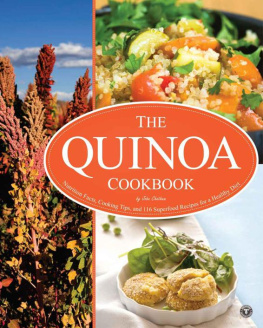
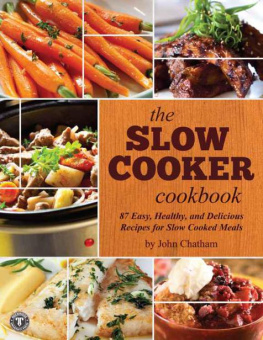
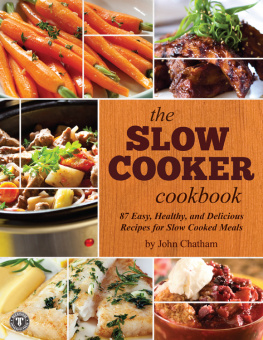

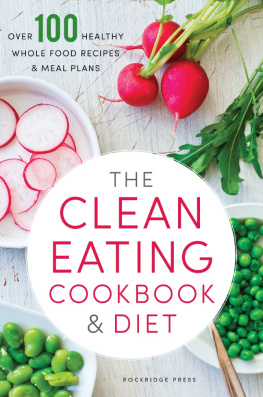
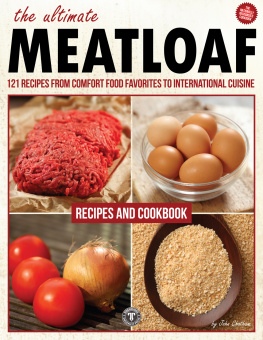
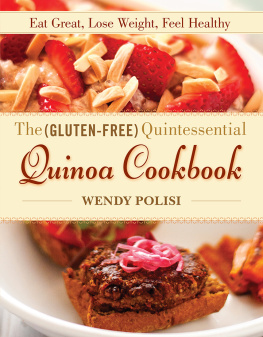
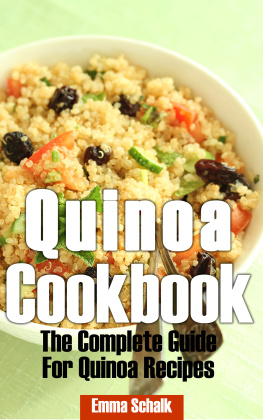

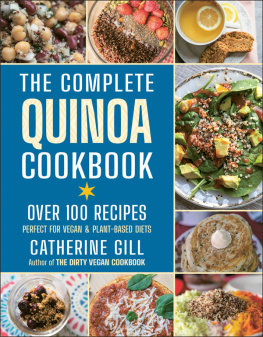
![Sacasa - The Quinoa [Keen-Wah] Cookbook](/uploads/posts/book/233264/thumbs/sacasa-the-quinoa-keen-wah-cookbook.jpg)
